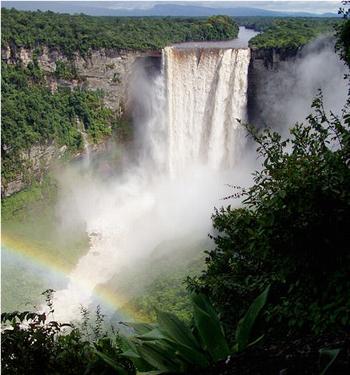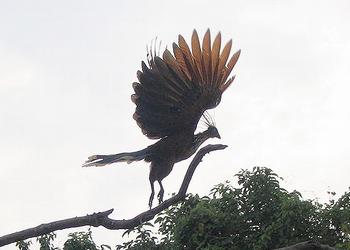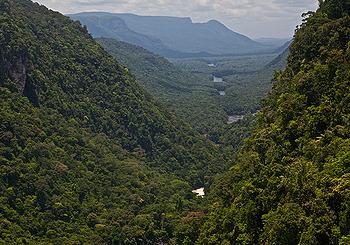Guyana Deforestation Triples Despite Funding for Forest Protection
GEORGETOWN, Guyana, March 7, 2011 (ENS) – Deforestation rates in the South American country of Guyana have increased during the last year, despite a 2009 agreement with the Norwegian government aimed at supporting forest protection to avert climate change, the nonprofit watchdog organization Global Witness said today.
Signed in November 2009 and worth up to US$250 million over four years, the agreement was initially welcomed as a potential breakthrough, and a blueprint for other countries to follow to preserve forests. Deforestation and land use change contributes 20 to 25 percent of the carbon emissions that cause climate change.
The agreement provides that Norway will pay for Guyana’s performance on limiting greenhouse gas emissions from deforestation and forest degradation, and for progress made against governance-related indicators. Guyana will invest the payments it receives, and any income earned on them, in its Low Carbon Development Strategy.
 |
Kaieteur Falls on the Potaro River in Kaieteur National Park is in the center of Guyana’s rainforest. (Photo by Sorenriise) |
However, once the technical details were made public, initial optimism gave way to widespread concern since a clause in the agreement allows deforestation rates in Guyana to increase, at Norway’s expense.
Located on the northern coast of South America, Guyana is about the size of Great Britain. One of the world’s last intact tropical rainforests covers some 18.5 million hectares, about 87 percent of the country’s land area. Guyana has one of the highest levels of biodiversity of any country, with some 8,000 plant species, half of which are endemic.
“Over the past year, deforestation rates in Guyana have increased 300 percent,” said Laura Furones of Global Witness. “It’s too early to say if this increase is a direct result of the flawed data in the agreement, but there is undoubtedly an incentive for Guyana to both profit from expanding forestry activities and simultaneously get paid by Norway to reduce deforestation.”
The clause assumed an existing annual baseline deforestation rate in Guyana of 0.45 percent on an interim basis until a more accurate baseline could be determined.
A January report commissioned by the Guyana Forestry Commission, and carried out by New Zealand-based consultants, Pöyry Forest Industry, concluded that the actual deforestation rate over the period 1990-2009 was in fact only 0.02 percent.
So, if the interim baseline is not adjusted under the terms of the agreement, deforestation in Guyana could increase 20-fold and still remain within the agreed limits.
The report confirmed that over the first year of the agreement the rate of actual deforestation in the country had trebled, reaching 0.06 percent.
Furones said, “The Norwegian and Guyanese governments must therefore adopt the precautionary principle to ensure that this is not the beginning of an upward trend that threatens local livelihoods and biodiversity.”
 |
The hoatzin is Guyana’s national bird. (Photo by Warren H. ) |
Uncertainties about actual levels of deforestation were acknowledged by the Norwegian and Guyanese governments soon after the deal was negotiated. At that time, both agreed to set a new reference level as close as possible to Guyana’s historical deforestation rate when further data was available.
The Pöyry report confirms that the interim deforestation rate was unrealistically high, and Global Witness is urging governments of Guyana and Norway to set a new reference level when they meet later this month.
Global Witness says a new reference level must be based on accurate historical data and ensure compensation is only paid to the government of Guyana if it takes positive steps to tackle the existing human pressures on Guyana’s forests, including logging and mining.
“It’s in nobody’s interests to see Guyana’s forests disappear or Norwegian taxpayers’ money go to waste” said Furones.
The agreement extends REDD+, formally known as the UN Collaborative Programme on Reducing Emissions from Deforestation and Forest Degradation in Developing Countries. The agreement between Guyana and Norway seeks to embark on one of the first national-scale REDD-plus initiatives in the world.
 |
The forest of central Guyana bisected by the Potaro River on its way to join with Guyana’s largest river, the Essequibo (Photo by Paul Bertner) |
The Guyana REDD+ Investment Fund was established in October 2010 with the World Bank acting as the Trustee. The first payment from Norway to the fund of US$30 million was processed at that time.
Ashni Singh, Minister of Finance of Guyana said then, “Today represents a big step forward in our joint efforts to show that we can create a low deforestation, low carbon, climate resilient economy in Guyana. Our two countries are forging new ground in trying to work out how REDD+ can help to reconcile the world’s need for urgent action to avert climate catastrophe with Guyana’s sustainable development.”
“Whilst we applaud the Norwegian government for its leading role in efforts to preserve the world’s rainforests,” said Furones today, “it must recognize that if their agreement does not demand a deviation from business as usual, then this deal will undermine global efforts to protect forests and mitigate climate change.”
“Both governments must take the findings of this report seriously and renegotiate the agreement based on the reality on the ground,” Furones said. “Only a dramatic reduction in the baseline rate will secure this and show that the Guyana-Norway agreement is succeeding in incentivizing the protection of Guyana’s forests.”
Guyana is also receiving payments from Germany to preserve its rainforest. On April 10, 2010, Finance Minister Singh and German Ambassador to Guyana Ernest Martens signed an agreement making an additional five million euros available to fund forest protection. This second agreement takes Germany’s financial support for Guyana’s tropical rainforest up to 8.1 million euros.
Part of Germany’s long-term support to the fight against climate change in the Caribbean Community Region, the funds are supposed to safeguard Guyana’s existing protected areas, and establish new protected areas as well.
Copyright Environment News Service (ENS) 2011. All rights reserved.
© 2011 – 2012, Environment News Service. All rights reserved. Content may be quoted only with proper attribution and a direct link to the original article. Full reproduction is prohibited.
